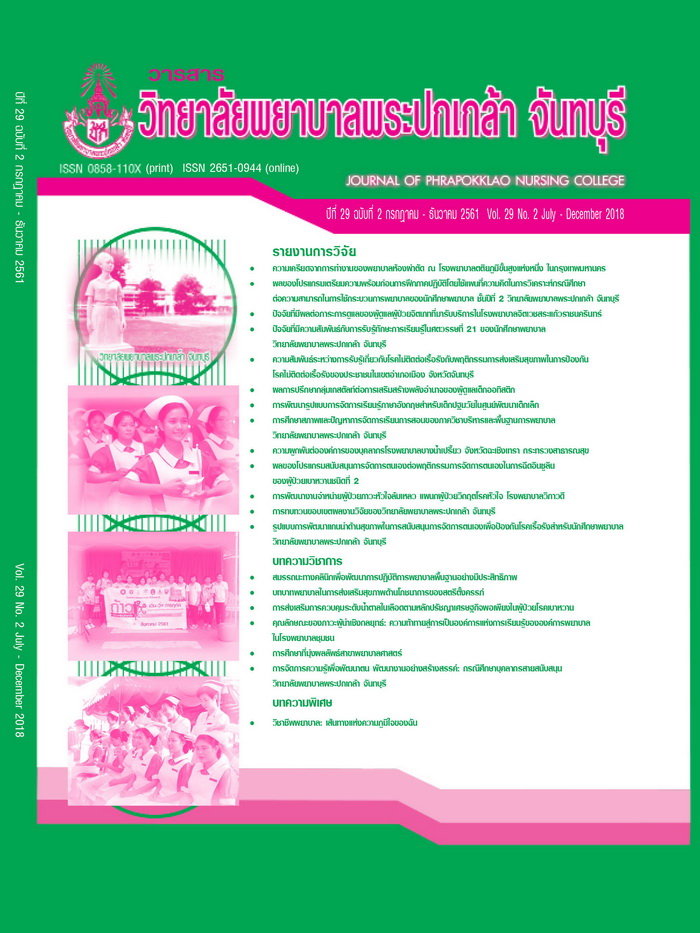The Relationship between Perception toward Non-communicable Diseases and Health Promotion Behaviors for Non-communicable Diseases Prevention among People in Muang District, Chanthaburi Province
Keywords:
Perception, Non-communicable disease, Health promotion behaviors, Disease preventionAbstract
This correlational research aimed to examine the relationship between perception toward non-communicable diseases and health promotion behaviors for non-communicable diseases prevention among people. The samples consisted of 240 people without non-communicable diseases who lived in Muang District, Chanthaburi Province in A.D. 2017. The research instrument was a 3-part questionnaire that comprised demographic data, perception toward non-communicable diseases with the reliability of .80, and health promotion behaviors for non-communicable diseases prevention with the reliability of .80. Data were collected from September to November, 2017. Statistics used for data analysis included frequency, percentage, mean, standard deviation, and Pearson’s product moment correlation.
The research results revealed that 1) the people had mean scores of perception toward causes of non-communicable diseases, perception toward effects of non-communicable diseases, and perception toward social support on health promotion at a high level (M = 3.92, SD = 1.27; M = 4.06, SD = 1.30 and M = 4.32, SD = 1.03, respectively); 2) the people had mean score of health promotion behaviors for non-communicable diseases prevention at a moderate level (M = 3.57, SD = 1.30); and 3) perception toward causes of non-communicable diseases, perception toward effects of non-communicable diseases, and perception toward social support on health promotion were positively statistically significant related to health promotion behaviors for non-communicable diseases prevention (r = .243, p < .001, r = .265, p < .001 and r = .301, p < .001, respectively).
This research suggests that health care providers should educate people regarding non-communicable diseases through various patterns and appropriately with their contexts, especially in the aspects of causes of diseases, medical checking up, exercise, and avoiding strong-flavored food in order to enhance perception and health promotion behaviors among people.
References
กลุ่มยุทธศาสตร์และแผนงาน สำนักโรคไม่ติดต่อ. (2559). รายงานประจำปี 2558. กรุงเทพฯ: สำนักงานกิจการโรงพิมพ์องค์การสงเคราะห์ทหารผ่านศึกในพระบรมราชูปถัมภ์. สืบค้นจาก http://www.thaincd.com/document/file/download/paper-manual/Annual-report-2015.pdf
ทรรศนีย์ โกศัยทิพย์. (2552). ความสัมพันธ์ระหว่างพฤติกรรมสุขภาพและภาวะสุขภาพในผู้สูงอายุ (วิทยานิพนธ์ปริญญามหาบัณฑิต). พิษณุโลก: มหาวิทยาลัยนเรศวร.
บุบผาชาติ ทีงาม, เยาวภา ติอัชสุวรรณ, และช่อทิพย์ บรมธนรัตน์. (2555). ปัจจัยที่มีผลต่อการปฏิบัติในการป้องกันโรคเบาหวานและโรคความดันโลหิตสูงของประชากรกลุ่มเสี่ยงในเขตพื้นที่รับผิดชอบของสถานีอนามัยบ้านโพนม่วง อำเภอชุมพลบุรี จังหวัดสุรินทร์. วารสารวิจัยและพัฒนาระบบสุขภาพ, 5(3), 127-134.
ประนอม โอทกานนท์. (2554). ชีวิตที่สุขสมบูรณ์ของผู้สูงอายุไทย. กรุงเทพฯ: แอคทีฟ พริ้นท์.
ปรารถนา วัชรานุรักษ์, และอัจฉรา กลับกลาย. (2560). ปัจจัยที่มีอิทธิพลต่อพฤติกรรมการป้องกันโรคในผู้ป่วยกลุ่มเสี่ยงโรคหลอดเลือดสมอง จังหวัดสงขลา. วารสารเครือข่ายวิทยาลัยพยาบาลและการสาธารณสุขภาคใต้, 4(1), 217-233.
ศิริรัตน์ โกศัลวัฒน์. (2548). มโนทัศน์พื้นฐานทางการพยาบาล. สงขลา: กอปปี้คอร์เนอร์ดิจิตอลปริ้นเซนเตอร์.
ศูนย์ข้อมูลสุขภาพที่ 6 สำนักงานสาธารณสุขจังหวัดจันทบุรี. (2559). รายงานโรคไม่ติดต่อ จังหวัดจันทบุรี ประจำปี 2559. สืบค้นจาก http://www.chpho.go.th/web2014/
สำนักงานกองทุนสนับสนุนการสร้างเสริมสุขภาพ. (2560). กลุ่มโรค NCDs โรคที่คุณสร้างเอง. สืบค้นจาก http://www.thaihealth.or.th/microsite/categories/5/ncds/2/173/176-กลุ่มโรค+NCDs.html
สำนักสารนิเทศ กระทรวงสาธารณสุข. (2559). สธ. เผยโรคไม่ติดต่อเรื้อรังเป็นสาเหตุการเสียชีวิตร้อยละ 73 ของการเสียชีวิตของประชากร เร่งพัฒนาสมรรถนะแก่บุคลากรเพื่อลดผู้ป่วยรายใหม่. สืบค้นจาก http://pr.moph.go.th/iprg/include/admin_hotnew/show_hotnew.php?idHot_new=89828
สำนักโรคไม่ติดต่อ กรมควบคุมโรค. (2559). สถิติข้อมูลโรคไม่ติดต่อเรื้อรัง. สืบค้นจาก www.thaincd.com
สำนักโรคไม่ติดต่อ กรมควบคุมโรค. (2560). รายงานประจำปี 2560. กรุงเทพฯ: อักษรกราฟฟิคแอนด์ดีไซน์. สืบค้นจาก http://www.thaincd.com/document/file/download/paper-manual/NCDReport60.pdf
สุพัชยา วิลวัฒน์. (2551). ความสัมพันธ์ของการรับรู้ความเชื่อด้านสุขภาพกับพฤติกรรมการป้องกันโรคเบาหวานในญาติสายตรงของผู้ที่เป็นเบาหวานประเภท 2 (วิทยานิพนธ์ปริญญามหาบัณฑิต). กรุงเทพฯ: มหาวิทยาลัยมหิดล.
โสภณ เมฆธน. (2559). ข่าวเพื่อสื่อมวลชน สำนักสารนิเทศ กระทรวงสาธารณสุข. สืบค้นจาก http://pr.moph.go.th/iprg/module.php?mod=news_print&idHot_new=89828
อัจฉรา จินดาวัฒนวงศ์, นพวรรณ เปียซื่อ, และพัชรินทร์ นินทจันทร์. (2555). ความสัมพันธ์ระหว่างการรับรู้ความเชื่อด้านสุขภาพกับพฤติกรรมการป้องกันโรคเบาหวานชนิดที่ 2 ในนักเรียนมัธยมศึกษาตอนปลาย. รามาธิบดีพยาบาลสาร, 18(1), 58-68.
อาภรณ์ ดีนาน. (2555). การสร้างเสริมสุขภาพวัยผู้ใหญ่. ใน ศิริพร ขัมภลิขิต และจุฬาลักษณ์ บารมี (บ.ก.), คู่มือการสอนการสร้างเสริมสุขภาพในหลักสูตรพยาบาลศาสตรบัณฑิต (น. 377-425). ขอนแก่น: โรงพิมพ์คลังนานาวิทยา.
อุทัย สุดสุข, พิทยา จารุพูนผล, ประยูร ฟองสถิตย์กุล, จรัล เกวลินสฤษดิ์, สัมฤทธิ์ จันทราช, และจรรยา เสียงเสนาะ. (2552). โครงการศึกษาสถานการณ์ความสมารถในการปฏิบัติกิจวัตรประจำวัน ความต้องการ และคุณภาพชีวิตของผู้สูงอายุ (รายงานผลการวิจัย). กรุงเทพฯ: สำนักงานคณะกรรมการวิจัยแห่งชาติ.
Becker, M. H., Haefner, D. P., Kasl, S. V., Kirscht, J. P., Maiman, L. A., & Rosenstock, I. M. (1977). Selected psychosocial models and correlates of individual health-related behaviors. Medical Care, 15(5 Suppl.), 27-46.
Cummings, K. M., Jette, A. M., Brock, B. M., & Haefner, D. P. (1979). Psychosocial determinants of immunization behavior in a swine influenza campaign. Medical Care, 17(6), 639-649.
Maiman, L. A., & Becker, M. H. (1974). The health beliefs model: Original and correlates in psychological theory. In M. H. Becker (Ed.), The health beliefs model and personal health behavior (pp. 9-26). Thorofare, NJ: Slack.
Paige, S. R., Bonnar, K. K., Black, D. R., & Coster, D. C. (2018). Risk factor knowledge, perceived threat, and protective health behaviors: Implications for type 2 diabetes control in rural communities. The Diabetes Educator, 44(1), 63-71.
Pender, N. J. (1996). Health promotion in nursing practice (3rd ed.). Connecticut: Appleton & Lange.
Polit, D. F., & Hungler, B. P. (1999). Nursing research: Principles and methods (6th ed.). Philadelphia: Lippincott.
Rosenstock, I. M. (1974). The health belief model and preventive health behavior. Health Education Monographs, 2(4), 354-386.
Downloads
Published
How to Cite
Issue
Section
License
Copyright (c) 2018 JOURNAL OF PHRAPOKKLAO NURSING COLLEGE

This work is licensed under a Creative Commons Attribution-NonCommercial-NoDerivatives 4.0 International License.
เนื้อความ ข้อมูล และรายการอ้างอิงที่ผู้เขียนใช้ในการเขียนบทความเพื่อลงตีพิมพ์ในวารสารวิทยาลัยพยาบาลพระปกเกล้า จันทบุรี ถือเป็นความคิดเห็นและความรับผิดชอบของผู้เขียน คณะผู้จัดทำวารสารไม่จำเป็นต้องเห็นพ้องด้วยหรือร่วมรับผิดชอบ
บทความที่ได้รับการลงตีพิมพ์ในวารสารวิทยาลัยพยาบาลพระปกเกล้า จันทบุรี ถือเป็นลิขสิทธิ์ของวารสารวิทยาลัยพยาบาลพระปกเกล้า จันทบุรี หากหน่วยงานหรือบุคคลใดต้องการนำส่วนหนึ่งหรือทั้งหมดของบทความไปเผยแพร่ต่อเพื่อวัตถุประสงค์ใด ๆ จะต้องได้รับอนุญาตจากบรรณาธิการวารสารก่อน



